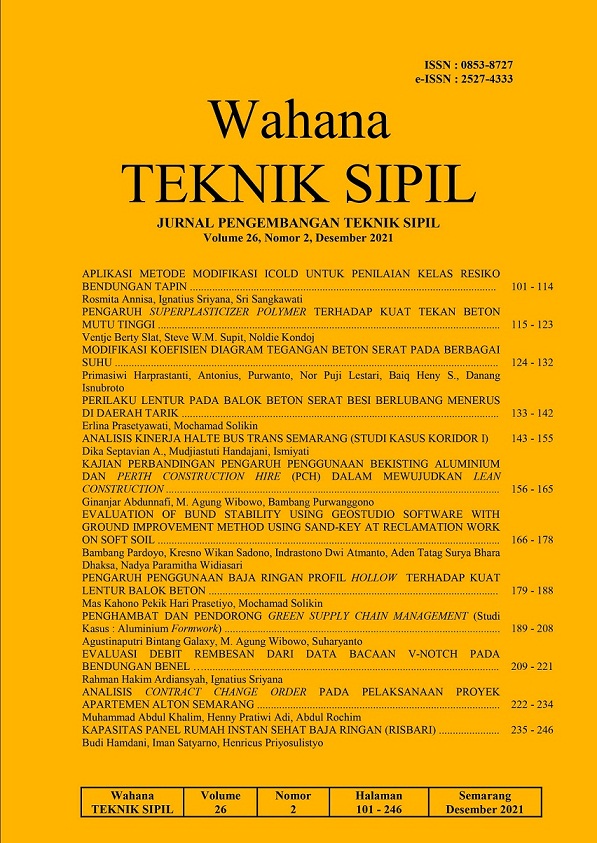PENGARUH SUPERPLASTICIZER POLYMER TERHADAP KUAT TEKAN BETON MUTU TINGGI
DOI:
https://doi.org/10.32497/wahanats.v26i2.3126Keywords:
Beton Mutu Tinggi, Superplastcicizer polymer, Kuat Tekan, Precast, Pre-stressAbstract
In construction field, the use of high performance concrete is essential for pre-cast and pre-stress concrete production where the addition of chemical admixture was found effectively contributes in strength. This research presents the results of using Superplasticizer polymer type Ligno C-165 in making high strength concrete. The percentage use of this material is 0.25%, 0.5%, 0.75%, 1%, 1.25% and 1.5% by weight of cement. The concrete samples were tested at the age of 3, 7, 14, 21 and 28 days after water curing. The results show that the addition of 1.5% SP increased the strength of concrete at 28 days with strength value of 64.97 MPa or 166.08% stronger than the target strength of f”™c=40 MPa. This is an indication that the increase of Superplasticizer polymer type Ligno C-165 dosage in concrete will also increases the strength that can be due to the effect of SP in reducing the water content that may produces denser matrix concrete with less volume of voids resulted in improving the properties of high strength concrete. From the results, the application of this mixture proportions could be used for producing building construction elements in the field of civil engineering.References
Aer, A.A., Sumajouw, M.D.J., dan Pandaleke, R.E., 2014, Pengaruh Variasi Kadar Superplasticizer Terhadap Nilai Slump Beton Geopolymer, Jurnal Sipil Statik, Vol. 1, No.6, September 2014 (283-291), ISSN: 2337-6732.
American Society for Testing and Materials (ASTM) C39/C39M-20, Standar Test Method for Compressive Strength of Cylindrical Concrete Specimens. ASTM International, West Conshohocken, PA, 2019, www.astm.org.
American Society for Testing and Materials (ASTM) C494M-19, Standard Specification for Chemical Admixtures for Concrete, ASTM International, West Conshohocken, PA, 2019, www.astm.org.
Antoni, Sugiharto, H., 2007, Kompatinilitas Antara Superplasticizer Tipe Polycarboxylate Dan Naphthalene Dengan Semen Lokal. Konferensi Nasional Teknik Sipil I (Konteks I), Universitas Atma Jaya Yogyakarta, Yogyakarta 11-12 Mei 2007, ISBN: 979.9243.80.7.
Herwani, Imran, I, Budiono, B, Pane, I, Zulkifli, E, dan Elvira., 2018, Efektivitas superplasticizer terhadap workabilitas dan kuat tekan beton geopolimer. PORTAL Jurnal Teknik Sipil, Vol.10, No.2, hal. 12-18.
Liu, Z., Zhao, K., Hi, C., and Tang, Y., 2016, Effect of Water-Cement Ratio on Pore Structure and Strength of Foam Concrete. Advances in Materials Science and Engineering, Vol.2016, Article ID 9520294, 9 pages.
Mariani, Sampebulu, V., dan Ahmad, A.G., 2009, Pengaruh Penambahan Admixture Terhadap Karakteristik Self Compacting Concrete (SCC), Jurnal SMARTEK, Vol. 7, No. 3, pp. 176-183.
Megasari, S.W., dan Winayati, 2017, Analisis Pengaruh Penambahan Sikament-NN Terhadap Karakteristik Beton. Jurnal Teknik Sipil Siklur, Vol. 3, No.2, hal. 117-128.
Mulyono, Tri, 2003. Teknologi Beton. Andi. Yogyakarta
SNI 03-2834-2000, Tata Cara Pembuatan Rencana Campuran Beton Normal. Jakarta: Badan Standarisasi Nasional.
Zardi, M., Rahmawati, C., Azman, T.K., 2016, Pengaruh Persentase Penambahan Sika Viscocrete-10 Terhadap Kuat Tekan Beton, Jurnal Teknik Sipil Unaya, Vol. 1, No. 1, pp.13-24, ISSN: 2407-733X
Downloads
Published
Issue
Section
License
Authors who publish with this journal agree to the following terms:Authors retain copyright and grant the journal right of first publication with the work simultaneously licensed under a Creative Commons Attribution License that allows others to share the work with an acknowledgement of the work's authorship and initial publication in this journal.
Authors are able to enter into separate, additional contractual arrangements for the non-exclusive distribution of the journal's published version of the work (e.g., post it to an institutional repository or publish it in a book), with an acknowledgement of its initial publication in this journal.
Authors are permitted and encouraged to post their work online (e.g., in institutional repositories or on their website) prior to and during the submission process, as it can lead to productive exchanges, as well as earlier and greater citation of published work (See The Effect of Open Access).






